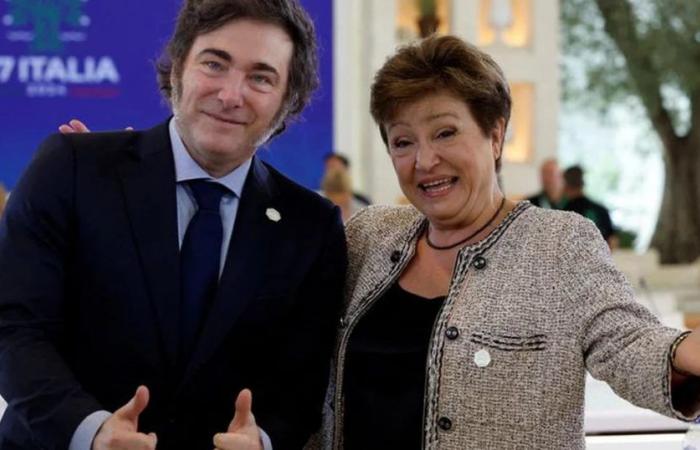
In the last review of the Argentine program the International Monetary Fund (IMF) gave some clues about what awaits the Argentine economy, in particular about the future of the dollar, the exchange rate, interest rates and the currency competition scheme promoted by the Government of Javier Milei.
Latest staff report of the organization, published on Monday, reflected the need for exchange rate policy to become more flexible to ensure the accumulation of reserves in the central bank, essential to face the debt commitments that Argentina has since next year. The gradual dismantling of foreign currency access restrictions and a positive interest rate are fundamental for the Fund.
The Minister of Economy, Luis Caputoand the head of the BCRA, Santiago Bausili, they plan to advance on that path but warned in a recent joint statement that the speed will depend on not putting the stability of the dollar and the slowdown in inflation at risk. The horizon is the coin competition that Milei promises.
The latest IMF document raised the need for a more flexible exchange rate policy. The roadmap foresees the elimination in June of the “dollar blend” for exporters, which allows 20% of the foreign currency deposited in the CCL to be settled, and the end of the PAIS tax by the end of the year.
In that sense, Caputo recently said that if the ruling party achieves approval of the Base Law and the fiscal package in Congress, progress could be made in a reduction from 17.5% to 7.5% in the PAIS tax rate. This is a tax paid by almost all sectors that want to earn foreign currency to go abroad.
In any case, different officials from the Ministry of Economy commented that the differential exchange rate for exporters will not be modified. The cereals They ask for a higher dollar to accelerate settlements in a context in which the BCRA began to sell reserves in the exchange market.
“The BCRA contemplates advancing in the liberation of exchange controls and greater exchange flexibility as long as these measures do not imply excessive risks for the process of reducing inflation and strengthening its balance sheet, as reflected in the Agreement. The process will be defined by the Argentine authorities themselves, contemplating the evolution of the relevant economic variables, who will share with the IMF the parameters that will be monitored, without including commitments of specific dates or measures,” explained the monetary authority and the Treasury Palace in a joint statement that was published before the last one was released staff report.
For the Fund, the real exchange rate appreciated 40% after the strong devaluation that Milei applied in the first days of his mandate, although technicians consider that it is at a level of “medium-term equilibrium.” This account includes the additional 17.5% of the PAIS tax.
On the interest rate side, the organization asked to support the transition to a new monetary regime and avoid market pressures. For this, he recommended that monetary policy rates become positive in real terms.
“This will also help recover demand for money as capital controls are lifted. In the last debt tender, the Treasury paid a monthly rate of 4.25% on Lecaps and said that the negative rate process had ended. However, for this rate to be positive, inflation must be lower, something that was verified in May, but we doubt it will be repeated in the coming months. It is also unclear how the actual rate will be measured against. It is not the same to use past or expected inflation,” said the consulting firm. Econviewsfrom the former Minister of Finance, Miguel Kiguel.
The scheme of coin competition began to appear officially in the conversations between the Government and the Monetary Fund, and it even already exists some degree of agreement about what elements will support that monetary system to which the economic team aims to migrate in the coming months.
Real interest rate positive in pesos to favor demand in pesos, a Central Bank with rtotal funding squeeze to the Treasury – something that could be established by law – but with functions of lender of last resort to banks and liquidity management through public securities and a managed float –not free– of the dollar after exchange rate unification.
These were some of the elements that Argentine technicians and officials identified as columns of the currency competition. There were no references, throughout the document, to Specific dates of implementation of the new scheme, and The idea of dollarization was not mentioned either. complete of the economy.
Currency competition was explained by the IMF in one of the monetary policy analysis sections and, later in the official document, it was also mentioned by the Government, which also regularly displays in the staff report their own vision of the measures underway and those to come. From Buenos Aires and Washington they recognized that the implementation of this program still you need to define different issues.
“While key fundamentals are being developed, eventual ‘currency competition’ within the regime could leave it resembling the currency system. managed flotation prevailing today in Peru and Uruguay”, mentioned the technicians. These two countries had, in recent decades, systems of bimonetary economy which allowed them to lower inflation consistently. Neither nation completely dollarized its economy, but it did allow the use of the North American currency for savings and exchange.

